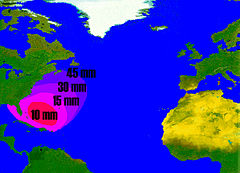American eel
| American eel | |
|---|---|
 |
|
 |
|
| Scientific classification | |
| Kingdom: | Animalia |
| Phylum: | Chordata |
| Class: | Actinopterygii |
| Superorder: | Elopomorpha |
| Order: | Anguilliformes |
| Family: | Anguillidae |
| Genus: | Anguilla |
| Species: | A. rostrata |
| Binomial name | |
|
Anguilla rostrata Lesueur, 1821 |
|
 |
|
| Range map | |
The American eel (Anguilla rostrata) is a facultative catadromous fish found on the eastern coast of North America. Eels (Anguilla spp.) are fish belonging to the elopomorph superorder, a group of phylogenetically ancient teleosts. The American eel has a slender snakelike body that is covered with a mucous layer, which makes the eel appear to be naked and slimy despite the presence of minute scales. A long dorsal fin runs from the middle of the back and is continuous with a similar ventral fin. Pelvic fins are absent, and relatively small pectoral fin can be found near the midline, followed by the head and gill-covers. Variations exist in coloration, from olive green, brown shading to greenish-yellow and light gray or white on the belly. Eels from clear water are often lighter than those from dark, tannic acid streams.
The eel lives in fresh water and estuaries and only leaves these habitats to enter the Atlantic Ocean to start its spawning migration to the Sargasso Sea. Spawning takes place far offshore where the eggs hatch. The female can lay up to 4 million buoyant eggs a year, and dies after egg-laying. After the eggs hatch and the early-stage larvae develop into , the young eels move toward North America where they metamorphose into glass eels and enter freshwater systems where they grow as yellow eels until they begin to mature.
The American eel is found along the Atlantic coast including Chesapeake Bay and the Hudson River and as far north as the St. Lawrence River region. It is also present in the river systems of the eastern Gulf of Mexico and in some areas further south. Like all anguillid eels, American eels hunt predominantly at night, and during the day they hide in mud, sand or gravel very close to shore, at depths of roughly 5 to 6 feet. They feed on crustaceans, aquatic insects, small insects, and probably any aquatic organisms that they can find and eat. In the Lake Ontario system, they have been demonstrating dietary preferences towards the invasive round goby.
...
Wikipedia

